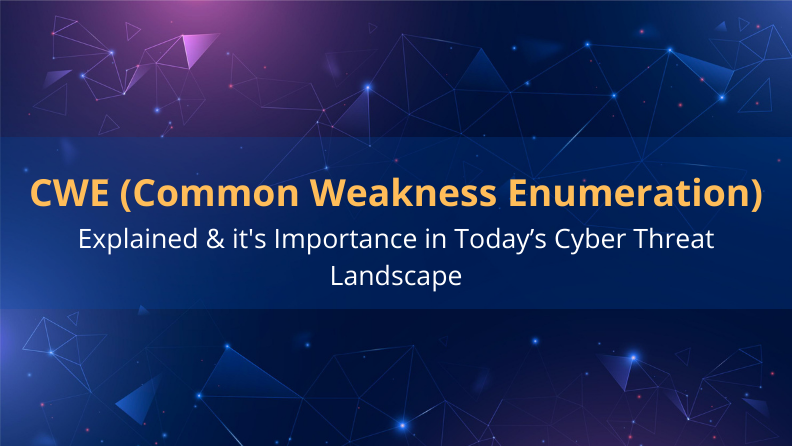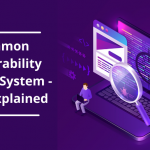Different types of security threats that have become rampant these days have made it essential for software and hardware developers to be extra cautious about the security aspects.
It is important to identify the weaknesses in hardware or software prior to deployment as they can provide ample opportunities for hackers to hack into a system. With diverse types of vulnerabilities existing today, it can be overwhelming to identify all the weaknesses lurking in a software or hardware.
To create awareness among developers and security professionals, CWE has curated a list of software and hardware weaknesses that can cause potential harm to the system and its users. This article will shed light on CWE which is a community-developed list that aims to help developers and security practitioners to eliminate common mistakes before the products are made available for widespread use.
CWE – Common Weakness Enumeration
CWE stands for Common Weakness Enumeration. It is a list that contains information about hardware and software weaknesses capable of compromising the security and integrity of the system. The term weaknesses translate to any flaws, errors or bugs in hardware or software design, code, implementation or architecture. Such weaknesses when left unchecked can have devastating impacts on the enterprise.
CWE serves as a universal online dictionary of all the weaknesses in software. Maintained by the MITRE corporation, CWE list is available for free access. CWE aims to educate hardware and software professionals about eliminating common errors before the products are publicly distributed. The CWE list is maintained by a group of experts from diverse backgrounds and aims to equip development and security teams with the necessary knowledge to nip security flaws in the bud.
It provides a standardized terminology and serves as a common language for security professionals and developers to discuss weaknesses in both software and hardware. CWE is useful to establish a common baseline standard for identifying weaknesses and initiating mitigation efforts. It also serves as a standard measuring stick that helps developers and security professionals to analyze security tools used to target these weaknesses.
CWE facilitates the comparison of similar products from multiple vendors and allows service providers to inform users of specific vulnerabilities. The list has benefits for legal personnel too as it can help them frame terms and conditions and prepare contracts relevant to particular software.
CWE List, what is it about?
The CWE list contains information on both hardware and software weaknesses. CWE list was first published in 2006. The list included only software weaknesses initially as those were more serious concerns at that time for all organizations striving to develop products free from security flaws. Classification trees and weaknesses were refined later on in the following releases and new content was added for mobile apps. The new content for mobile applications was added in 2014.
Over the years, hardware weaknesses too became important concerns. LoJax, Meltdown/Spectre, Rowhammer are some of the hardware security issues that pose a major threat to the system. Hardware weaknesses gained prominence in the list in 2020. CWE is a community effort and maintaining this list is an ongoing process. The list is continuously updated and refined depending on new technologies and situations that emerge in cyberspace.
There are three tiers to the CWE. The top tier breaks down weaknesses into general classes for the purpose of easy communication among vendors, enterprise management professionals and researchers. The middle tier comprises definitions that are useful for system administrators, security experts and software developers. The last tier contains the entire list that is useful for all people involved in the IT sector and even PC users. A number is assigned to each entry in the CWE list. Click here to get a better idea of the full list.
How to use the CWE list?
This list is freely accessible on a worldwide basis. You can view or download the full list that is relevant to your organization. One of the important features of CWE list is that it divides weakness types into three major categories to serve content most relevant to different communities within the IT sector. The list enables users with distinct viewpoints to effectively utilize the content.
While navigating through the CWE list, you will come across Software Development, Hardware Design and Research concepts. Each of these lists have organized weaknesses encountered by professionals in their respective disciplines. Software development view is specifically focused on flaws or security errors that interfere with software development. Hardware design view covers the security issues that emerge during the hardware design process. Lastly, research concepts help in the research of weakness types by listing items depending on their behaviors.
There are other predefined views too that pertain to a certain use case or domain. It includes weaknesses that inflict indirect damage on software in Java, C, C++ and PHP as well as mobile applications among others. Predefined views also deal with weaknesses that are introduced during design or implementation.
The CWE list also contains views that represent mappings to external groupings that includes OWASP Top Ten (2017), CWE Top 25 (2020), Software Fault Pattern Clusters, Seven Pernicious Kingdoms, CISQ Quality Measures (2020) and SEI CERT Coding Standards for Java, C and Perl. Views under external mappings also include a subset of entries that are related by some external factor.
There are also a few obsolete views listed. As the name suggests, these views are valid but no longer relevant as they have been replaced by more recent views. CWE list is created in such a way that it caters to the unique viewpoints of different users and enables you to utilize CWE content depending on your needs.
This list can be used by any organization or individual for research and commercial purposes. The usage terms are specified in the official website of CWE. MITRE corporation has copyrighted the CWE list to maintain it as a free and open standard for public use. CWE usage is permitted under the condition that MITRE’s copyright designation is maintained in any copy you produce.
Some crucial definitions in CWE
As discussed earlier, CWE has created definitions for each common weakness type. The main objective behind this is to facilitate a better understanding for organizations and individuals by ensuring all the items are accurately described and differentiated. Let’s now understand the definitions of ‘view by software development’, ‘view by hardware design’ and ‘view by research concepts’ in detail.
Software Development
This view is primarily concerned with the software development life cycle. All the aspects of software development from architecture to implementation are covered in this. There are several categories that help simplify navigation, mapping and browsing. Architects, coders, designers and testers stand to benefit from this view. This view provides better insights into errors that are commonly observed in certain areas of software.
This view has organized weaknesses around concepts that developers are familiar with enabling easy understanding and navigation of this view. Developers who want to utilize this view for a specific phase of the development lifecycle can easily do so by filtering by ‘Modes of instruction.’ This view is also beneficial for educators to educate developers on the potential mistakes that are bound to be present when it comes to certain parts of the codebase.
View by software development displays tree-like relationships between weaknesses existing at various levels of abstraction. Click here to view the complete list.
Hardware Design
Similar to software development, view by hardware design includes details about weaknesses revolving around concepts that are specific to hardware design. Mistakes in specific areas of IP design are quite common and this view rescues hardware designers from serious repercussions owing to such errors. This view entails familiar concepts which enables better understanding for hardware designers. Along with hardware designers, this view is targeted at educators too to help create awareness among future designers about the common mistakes made in hardware design.
Manufacturing and lifecycle management concerns, security flow issues, integration issues are among the weaknesses listed in this view. The weaknesses are presented in a simple, intuitive manner here. It is also important to note that the same weakness can exist in different categories. You can view the complete list by clicking here.
Research Concepts
The main objective of this view is to encourage research on weaknesses and understand gaps, if any, within CWE. This view organizes weaknesses based on abstractions of behaviors rather than focusing on their presence in certain areas of the code or stages at which they are introduced in the development process. This view is supposed to have listed every weakness within CWE.
This view is targeted at academic researchers, vulnerability analysts and assessment tool vendors. Academic researchers can use this view to analyze areas that have scope for further research. Vulnerability analysts can use this view to analyze relationships between higher-level classes and bases and detect weaknesses. Assessment vendors on the other hand can benefit from this view as it helps locate additional weaknesses that a tool can detect. This is possible as the relationships are aligned with the tool’s technical capabilities.
This view is designed to identify relationships that aren’t included in previous classifications. It covers relationships between weaknesses and includes at least one parent/child relationship for every weakness within the CWE. Click here to view the entire list under research concepts.
Conclusion
Dangerous software weaknesses that are easy to exploit pose a huge threat as hackers can take over a system and destroy your hard-earned reputation in seconds. Common software weaknesses include buffer overflows, structure and validity problems, channel and path errors, authentication errors, user interface errors among others. Hardware weaknesses include privilege separation and access control errors as well as issues in CPU, FPGA, graphics, AI, etc. Such weaknesses can lead to exploitable security vulnerabilities. CWE was thus created to help professionals address common hardware and software weaknesses.
It is a useful resource for programmers, hardware engineers, architects and educators alike. CWE list is an attempt to prevent vulnerabilities that have raised security concerns in both hardware and software industries. Since CWE is the result of a community effort, the content reflects the combined expertise of information technology and security professionals. Educators can also make this a part of the curriculum designed for hardware and software studies.
CWE is effective to enhance weakness identification and prevention efforts. It encourages active discussions around weaknesses in hardware and software which ultimately contributes to improved efforts in reducing risks industry-wide. CWE helps developers to eliminate weaknesses at an early stage and publish more refined versions of their products. The collaborative nature of CWE also means experts can put forth new content suggestions to keep the list relevant and updated in accordance with the changing times.
AppSealing is a top-notch mobile application security solutions provider that offers robust, cloud-based security solutions. With zero coding, add scalable security to your Android, iOS and Hybrid apps within minutes with no impact on app performance. Leverage reliable security solutions to ensure the best protection against theft and manipulation. Get in touch with our team today to track all hacking attempts and enhance your app security with real-time insights.
Frequently Asked Questions
1. What is CWE vs CVE?
CVE stands for Common Vulnerabilities and Exposures and CWE stands for Common Weakness Enumeration. CWE is simply a list of software and hardware weakness types and deals with the vulnerabilities without covering the instance within the product or system. CVE is a publicly disclosed information of security issues and deals with specific instances within a product or system.
2. What is the difference between CVE and CVSS?
CVE is a glossary that is used to analyze vulnerabilities. CVSS stands for Common Vulnerability Scoring System. After analyzing vulnerabilities using CVE, CVSS is used to determine the risk posed by a vulnerability. A CVE score helps determine and prioritize security vulnerabilities for enterprises.






